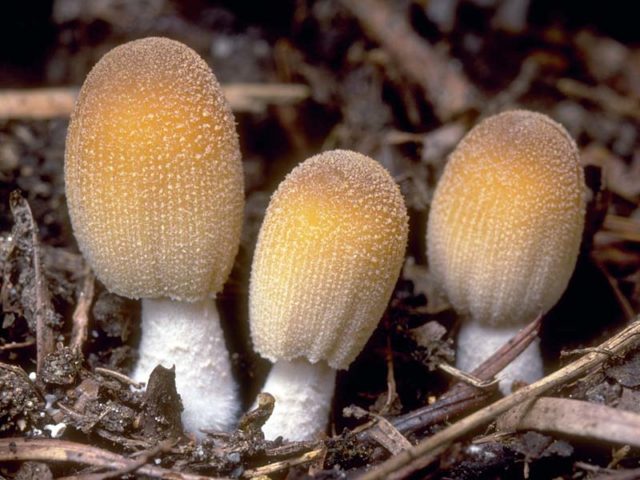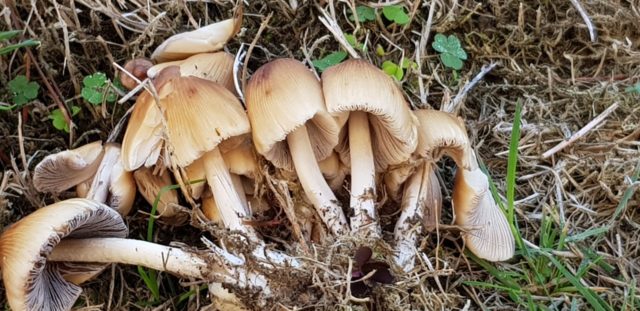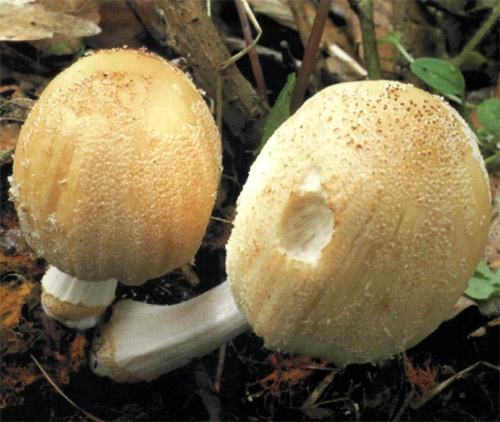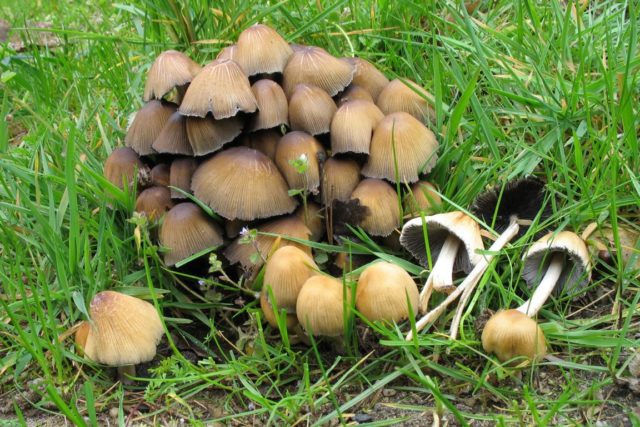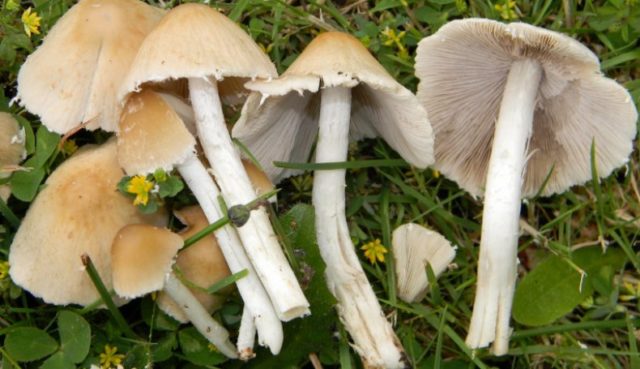Content
Flickering dung (crumbling), the Latin name Coprinellus micaceus belongs to the Psatirella family, genus Coprinellus (Coprinellus, Dung). Previously, the species was isolated into a separate group - Dung beetles. In Russia, its rare name is mica dung beetle. The species is referred to as saprotrophs - fungi that decompose wood. Its first description was presented in the first half of the 19th century.
Where the shimmering dung grows
The species grows in the northern and temperate climatic zone. The mycelium spreads on the remains of old wood from early spring to late autumn, before the first frost occurs. Early small specimens appear in early May. The period of active fruiting occurs in June-July. The species is found in forests, parks, in the courtyards of houses on the trunks of dead deciduous trees. You can find it in rural areas and in urban areas on garbage and compost heaps. The fungus grows everywhere in a moist and nutritious environment. It does not inhabit coniferous tree stumps and pine forests. Flickering dung is found in large crowded groups, families.
What a shimmering dung beetle looks like
It is a small mushroom, its length does not exceed 4 cm. The cap is bell-shaped, with downward-edged edges. In young specimens, an egg-shaped cap is found. Its diameter and height do not exceed 3 cm. The skin color is dirty yellow or brown, more intense in the center than along the edge. The surface of the cap is covered with small shiny scales that are easily washed off by sediments. The edges of the cap are more ribbed than the center, they can be even or torn.
The flesh of shimmering dung beetle is thin, delicate, fragile, fibrous, does not have a pronounced mushroom smell, and has a sour taste. In young mushrooms it is white, in old ones it is dirty yellow.
The leg is thin (no more than 2 cm in diameter), cylindrical, can expand to the bottom, hollow inside. Its length does not exceed 6-7 cm. The color is bright white, at the base it is yellow. Its surface is loose, velvety, there is no ring. The flesh of the leg is fragile, easily crumbles.
The plates of a young shimmering mushroom are white, cream, or light brown, frequent, adherent, quickly decompose, turn green. In wet weather, they blur, turn black.
The spore powder of the fungus is dark gray or black. Disputes are flat, smooth.
Is it possible to eat shimmering dung
This species resembles a toadstool, so mushroom pickers prefer to bypass it. The dung beetle is conditionally edible, but this applies only to young specimens, their plates and legs are still white. It is eaten after heat treatment (at least 20 minutes). The first mushroom broth must be drained. The mushroom should be cooked within an hour after picking, after a longer time it darkens, deteriorates, and can cause indigestion.
The pulp of dung beetle does not have a pronounced taste and smell. In combination with alcohol, it acquires an unpleasant bitter taste and can cause food poisoning. The first symptoms of intoxication are tachycardia, speech impairment, fever, decreased vision clarity. When cooking, do not mix with other types of mushrooms.
Flickering dung, like other members of the genus, contains the substance coprin, which blocks the absorption of alcohol by the human body. In folk medicine, dung beetle is used to treat alcoholism. After eating this species for another 48 hours later, you can not drink alcohol-containing substances - the likelihood of poisoning still persists.
Similar species
Many mushrooms of the genus Dung are similar to each other. They are all conditionally edible. Shimmering dung is similar to toadstool and edible honey fungus at the same time. Only an experienced mushroom picker can distinguish between these edible and inedible species.
Domestic dung (Coprinellus domesticus)
This is a larger and lighter mushroom than shimmering dung beetle. Its cap in diameter and leg in length can exceed 5 cm. The surface of the cap is not covered with shimmering plates, but with a velvety, white or creamy skin. The fungus is also a saprotrophic species that parasitizes old trees. He prefers to grow on aspen or birch stumps, on wooden buildings. In the wild, domestic dung beetle is rare, which is why it got its name.
The plates are also susceptible to autolysis - decomposition in a humid environment. In young mushrooms, they are white, over time they darken and turn into an ink mass.
Domestic dung is classified as an inedible species. Unlike shimmering dung beetle, domesticated dung grows singly or in small groups.
Willow dung (Coprinellus truncorum)
It is an edible member of the Psatirella family. Its other name is willow ink mushroom. In appearance, it is similar to a shimmering dung beetle. It features a longer and thinner off-white leg. The surface of the young mushroom is covered with a white, loose bloom, which is easily washed off by rains. The cap of a mature willow dung beetle is smooth, creamy, without roughness and shiny particles. In older representatives of the species, the skin is wrinkled, ribbed. In the center, the cap is brown, and the edges have a whitish stripe.
The pulp is thin, white, translucent, through it you can see the plates, which makes the mushroom appear wrinkled.
Willow dung grows in large families on well-fertilized meadows, fields, pastures, garbage heaps. It needs a moist nutrient medium.
Willow dung, like shimmering, is used only by young people, while the plates are still white. Mushroom pickers do not like it for its rapid decomposition process; in literally an hour, a strong yellow specimen can turn into a black jelly-like mass.
False mushroom
The mushroom can be mistaken for a shimmering dung. This species also grows on woody debris all over the place. False mushrooms have a thin white, hollow stem.
The false mushroom cap is yellow or light brown in color, but unlike the dung beetle, it is smooth and slippery. False honey gives off an unpleasant odor of dampness or mold. The plates on the back of the cap are olive or green. False mushrooms are inedible (poisonous) mushrooms. The poisonous representative of the species begins to bear fruit at the end of summer, while the shimmering dung beetle sprouts already at the beginning of May.
Conclusion
Shimmering dung is a mushroom that is ubiquitous almost throughout Eastern Europe and in Russia. It is considered a conditionally edible species, since the terms of use are very short. Inexperienced mushroom pickers may confuse it with edible honey. When interacting with alcohol, the mushroom becomes poisonous.Older species can also cause digestive upset. It is better for inexperienced mushroom pickers to refuse to collect.
